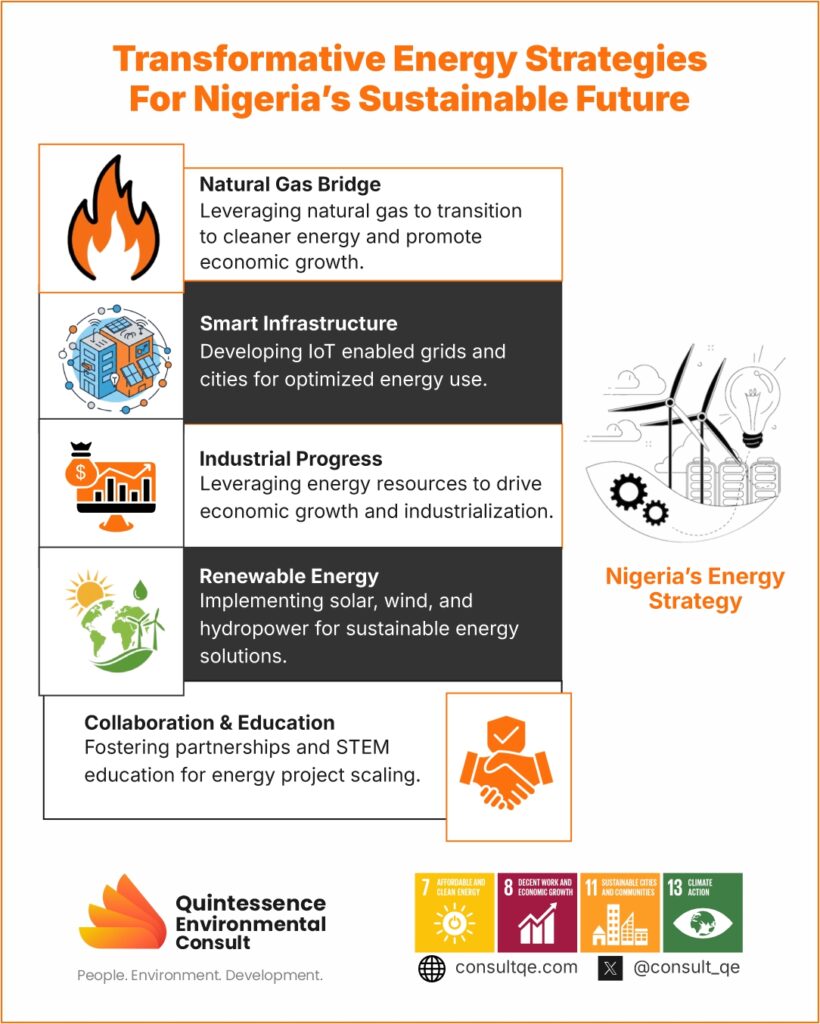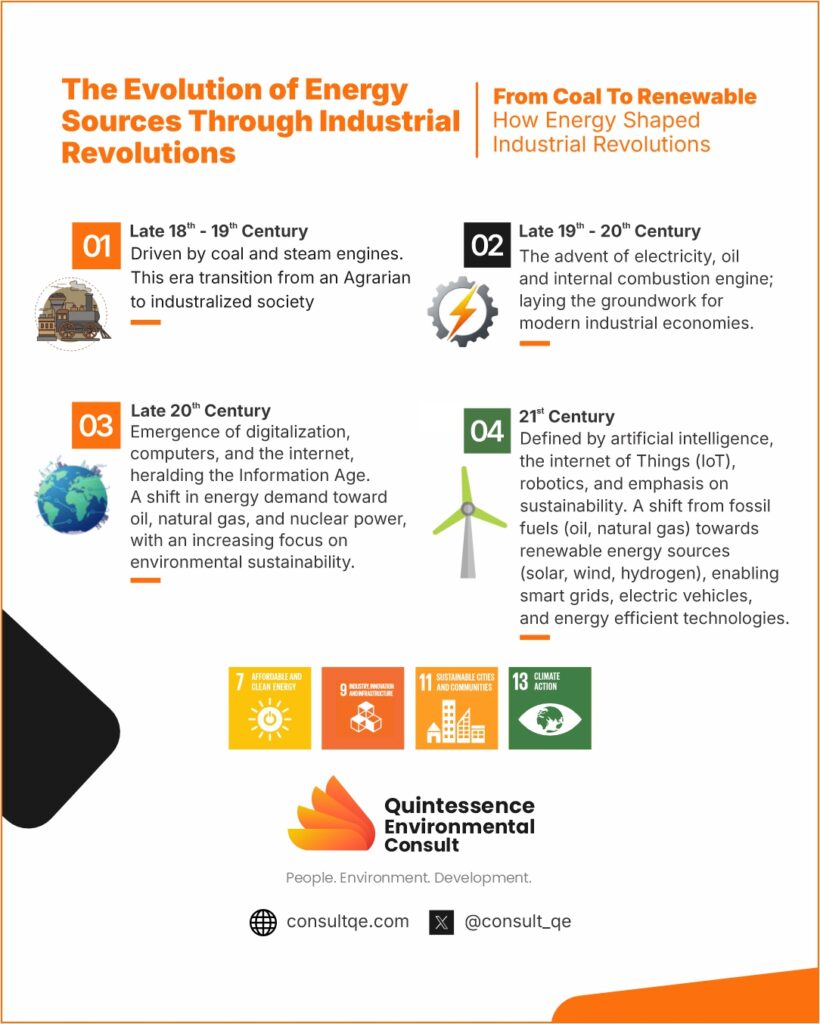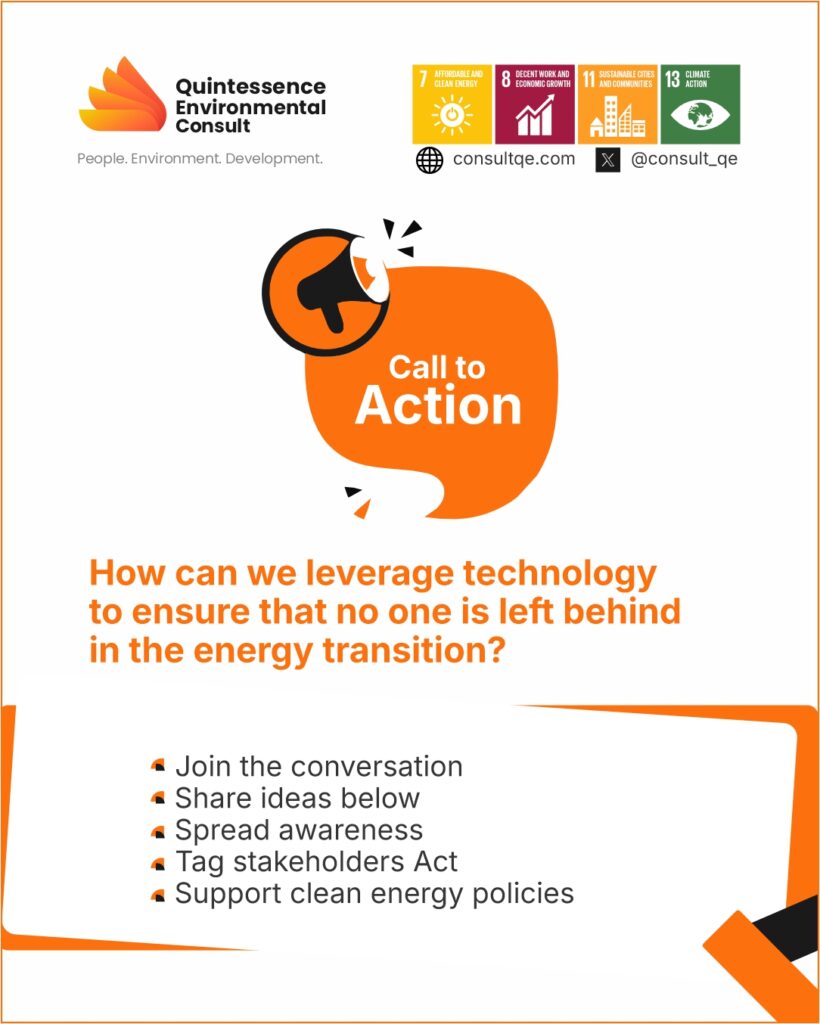Key Takeaways:
- Energy Drives Industrial Progress: Every industrial revolution has been powered by transformative energy sources. Nigeria must leverage its energy resources—natural gas and renewables—to fuel economic growth and industrialization.
- Natural Gas is a Bridge to Sustainability: Nigeria’s vast natural gas reserves can address energy poverty, power industries, and reduce reliance on dirtier fuels, aligning with SDG 7 (Clean Energy) and SDG 8 (Economic Growth).
- Renewables are Nigeria’s Future: Solar, wind, and hydropower offer clean, decentralized energy solutions, supporting SDG 13 (Climate Action) and SDG 9 (Innovation and Infrastructure).
- Smart Infrastructure is Essential: IoT-enabled smart grids and smart city projects can optimize energy use and support tech-driven industries, contributing to SDG 11 (Sustainable Cities).
- Collaboration and Education are Key: Public-private partnerships and investments in STEM education are crucial for scaling energy projects and building a skilled workforce, aligning with SDG 4 (Quality Education) and SDG 17 (Partnerships).

Introduction
Human progress has been profoundly shaped by industrial revolutions, each driven by transformative energy sources and technologies. From the steam engine to artificial intelligence, these revolutions have redefined economies, societies, and global power dynamics. For Nigeria, a nation rich in resources but grappling with energy poverty and economic challenges, understanding these revolutions offers a roadmap for sustainable development. This blog post explores the four industrial revolutions, the pivotal role of energy in each, and how Nigeria can strategically position itself to harness these lessons for growth and innovation.
The Evolution of Industrial Revolutions and Energy’s Central Role
The First Industrial Revolution (late 18th to early 19th century) marked the transition from agrarian economies to industrialized societies, powered by coal and steam engines. This era introduced mechanized production, revolutionizing industries like textiles and transportation. Coal became the backbone of economic growth, enabling mass production and the expansion of railways and factories. For example, the United Kingdom’s use of coal-powered steam engines not only transformed its economy but also set the stage for global industrialization.
The Second Industrial Revolution (late 19th to early 20th century) was defined by the advent of electricity, the internal combustion engine, and oil. Electricity became the lifeblood of industries and households, while oil transformed transportation and logistics. Henry Ford’s assembly line, powered by electricity, revolutionized manufacturing, making automobiles affordable and accessible. This period laid the foundation for modern industrial economies, demonstrating how energy accessibility can drive innovation and economic growth.
The Third Industrial Revolution (late 20th century) brought digitalization, computers, and the internet, ushering in the Information Age. Energy demand shifted towards oil, natural gas, and nuclear power, with growing awareness of environmental sustainability. For instance, the rise of Silicon Valley was fueled by reliable energy systems that powered data centers and communication networks. This revolution highlighted the importance of energy in enabling technological advancements and global connectivity.
The Fourth Industrial Revolution (21st century) is characterized by artificial intelligence, the Internet of Things (IoT), robotics, and a strong emphasis on sustainability. Renewable energy sources like solar, wind, and hydrogen are replacing fossil fuels, enabling smart grids, electric vehicles, and energy-efficient technologies. Countries like Germany, with its Energiewende (energy transition) policy, are leading the way in integrating renewables into their energy systems, demonstrating how innovation and sustainability can go hand in hand.
Nigeria’s Opportunity: Learning from the Past, Building for the Future
Nigeria stands at a critical juncture, with the potential to leverage its abundant natural resources and youthful population to drive sustainable development. By drawing lessons from the industrial revolutions, Nigeria can address its energy challenges and position itself as a leader in Africa’s economic transformation.
- Harnessing Natural Gas as a Transition Fuel: Nigeria boasts one of the largest natural gas reserves globally, yet much remains untapped. Natural gas can serve as a bridge fuel, providing a cleaner alternative to coal and oil while addressing the country’s energy deficit. For example, the Nigerian Liquefied Natural Gas (NLNG) project has already shown how gas can be monetized and used to generate electricity. Expanding such initiatives can stabilize electricity supply, power industries, and create jobs, aligning with SDG 7 (Affordable and Clean Energy) and SDG 8 (Decent Work and Economic Growth).
- Embracing Renewable Energy: With abundant sunlight, wind, and hydropower potential, Nigeria is well-positioned to transition to renewable energy. The Nigeria Electrification Project (NEP), which aims to provide off-grid solar power to rural communities, is a step in the right direction. By investing in renewable energy projects and incentivizing private sector participation, Nigeria can build a sustainable energy ecosystem that supports economic growth and environmental preservation, contributing to SDG 13 (Climate Action) and SDG 9 (Industry, Innovation, and Infrastructure).
- Building Smart Infrastructure: The Fourth Industrial Revolution emphasizes the importance of smart technologies and infrastructure. Nigeria can adopt IoT-enabled smart grids to optimize energy distribution, reduce waste, and improve access. For instance, the Lagos Smart City Project aims to integrate technology into urban planning, including energy management. Such initiatives can enhance energy reliability and resilience, supporting the growth of tech-driven industries and urban development, in line with SDG 11 (Sustainable Cities and Communities).
- Fostering Innovation and Education: A skilled workforce is essential to navigating the complexities of modern industrial and energy systems. Nigeria must prioritize STEM education and vocational training to build a talent pool that drives innovation. Programs like the African University of Science and Technology (AUST) in Abuja are already equipping students with the skills needed for the Fourth Industrial Revolution. This focus on education aligns with SDG 4 (Quality Education) and SDG 9.
- Encouraging Public-Private Partnerships: Collaboration between the government, private sector, and international organizations is crucial to scaling energy projects and industrial initiatives. For example, the Azura-Edo Power Plant, a public-private partnership, has added significant capacity to Nigeria’s electricity grid. Such collaborations can mobilize resources, share risks, and ensure the successful implementation of large-scale infrastructure projects, contributing to SDG 17 (Partnerships for the Goals).

Conclusion
The industrial revolutions have demonstrated that energy is the cornerstone of economic transformation. For Nigeria, the path to prosperity lies in strategically leveraging its energy resources, embracing renewable technologies, and fostering innovation. By learning from the past and adapting to the demands of the Fourth Industrial Revolution, Nigeria can unlock its immense potential, drive sustainable development, and emerge as a leader in Africa’s industrial and energy landscape.
The time to act is now. With the right policies, investments, and collaborations, Nigeria can turn its challenges into opportunities and build a future that benefits all its citizens while contributing to the global Sustainable Development Goals.

- Oyedepo, S.O. (2012). Energy and sustainable development in Nigeria: the way forward. Energy, Sustainability and Society, 2, 1-17.
- https://doi.org/10.1186/2192-0567-2-15
- Adeshina, M. A., Ogunleye, A. M., Suleiman, H. O., Yakub, A. O., Same, N. N., Suleiman, Z. A., & Huh, J. S. (2024). From potential to power: Advancing Nigeria’s energy sector through renewable integration and policy reform. Sustainability, 16(20), 8803. https://doi.org/10.3390/su16208803
- Ugwu, M. C., Adewusi, A. O., & Nwokolo, N. E. (2024). The Role Of Public-Private Partnerships In Building Clean Energy Infrastructure In The United States And Nigeria. International Journal of Management & Entrepreneurship Research, 6(4), 1049-1068. https://doi.org/10.52362/ijmer.2022.v4.3.984
- Amuda, Y. J., Hassan, S., & Subramaniam, U. (2023). Comparative review of energy, crude oil, and natural gas for exchange markets in Nigeria, India and Bangladesh. Energies, 16(7), 3151. https://doi.org/10.3390/en16073151
- Devenish, K., Desbureaux, S., Willcock, S., & Jones, J. P. (2022). On track to achieve no net loss of forest at Madagascar’s biggest mine. Nature Sustainability, 5(6), 498-508. https://doi.org/10.1038/s41893-022-00850-7
External Links Industrial Revolution: Definition, History, Pros, and Cons Launch of Nigeria’s Energy Transition Plan | Sustainable Energy for All ANALYSIS: Nigeria’s Energy Transition Plan: Challenges for Decade of Gas | Premium Times Nigeria




Great article.